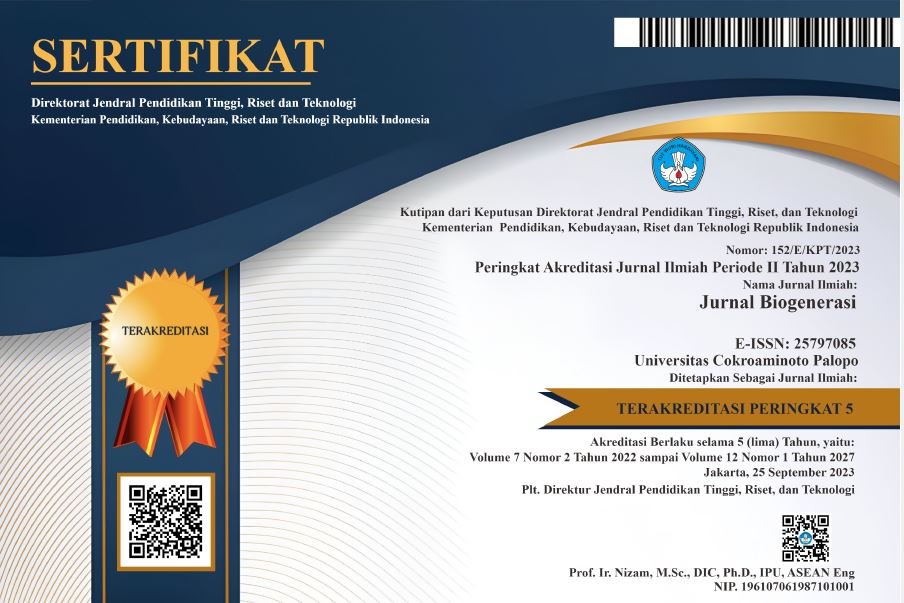K KELIMPAHAN JAMUR PADA DAUN KARET BERGEJALA PENYAKIT GUGUR DAUN KARET (GDK)
DOI:
https://doi.org/10.30605/biogenerasi.v10i2.6549Keywords:
kelimpahan, gugur daun karet, Hevea brasiliensisAbstract
Penyakit gugur daun tanaman karet disebabkan oleh jamur patogen yang menginfeksi jaringan pada daun tanaman karet, gejala yang timbul pada daun memiliki karakteristik yang berbeda-beda, hal ini disebabkan oleh perbedaan jenis jamur patogen yang menginfeksi daun tersebut. Penelitian ini bertujuan untuk mengetahui macam-macam jamur patogen yang diisolasi dari daun tanaman karet. Penelitian ini dilakukan di Laboratorium Fisiologi Unit Riset Sungei Putih. Penelitian ini menggunakan metode deskriptif kualitatif. Dari hasil isolasi daun bergejala gugur daun karet didapatkan 11 isolat jamur diantaranya 8 isolat yang telah teridentifikasi jamur patogen yaitu jamur Colletotrichum gloeosporidaes (1 isolat), Pestalotiopsis sp. (3 isolat), dan Corynespora cassiicola (4 isolat), dan yang teridentifikasi jamur antagonis yaitu jamur Penicillium sp. (2 isolat). Serta 1 isolat yang belum dapat teridentifikasi.
Downloads
References
Aliya, S. S. S., Nusaibah, S. A., Mahyudin, M. M., Yun, W. M., & Yusop, M. R. (2022). Colletotrichum siamense and Pestalotiopsis jesteri as potential pathogens of new rubber leaf spot disease via detached leaf assay. Journal of Rubber Research, 25(3), 195–212. https://doi.org/10.1007/s42464-022-00157-4
Atapattu, K., Hunupolagama, D., Wijesundera, R., Chandrasekharan, N., Wijesundera, W., Kathriarachchi, H., & Fernando, T. (2022). Identification and characterization of Colletotrichum gloeosporioides complex members from rubber plants in Sri Lanka. Plant Pathology & Quarantine, 12(1), 105–113. https://doi.org/10.5943/ppq/12/1/7
Chau, N. N. B., Van Minh, N., Nghiep, N. M., Vinh, N. P., Nghia, N. A., & Quoc, N. B. (2022). Identification and virulence evaluation of Corynespora cassiicola cassiicolin-encoding gene isolates from rubber trees in Vietnam. Tropical Plant Pathology, 47(3), 378–385. https://doi.org/10.1007/s40858-021-00470-0
Damiri, N., Pratama, Y., Febbiyanti, T. R., Rahim, S. E., Astuti, D. T., & Purwanti, Y. (2022). Pestalotiopsis sp. infection causes leaf fall disease of new arrivals in several clones of rubber plants. Biodiversitas, 23(8), 3943–3949. https://doi.org/10.13057/biodiv/d230811
Dixon, L. J., Schlub, R. L., Pernezny, K., & Datnoff, L. E. (2009). Host specialization and phylogenetic diversity of corynespora cassiicola. Phytopathology, 99(9), 1015–1027. https://doi.org/10.1094/PHYTO-99-9-1015
Du, Y., Wang, M., Zou, L., Long, M., Yang, Y., Zhang, Y., & Liang, X. (2021). Quantitative detection and monitoring of colletotrichum siamense in rubber trees using real-Time pcr. Plant Disease, 105(10). https://doi.org/10.1094/PDIS-10-20-2198-RE
Febbiyanti, T. R., & Fairuzah, Z. (2020). IDENTIFIKASI PENYEBAB KEJADIAN LUAR BIASA PENYAKIT GUGUR DAUN KARET DI INDONESIA. Jurnal Penelitian Karet, 193–206. https://doi.org/10.22302/ppk.jpk.v37i2.616
Herliyana, E. N., Oktavianto, P., & Siregar, U. J. (2022). Identification and characterization of Pestalotiopsis spp. causing leaf spot and leaf blight on jabon (Neolamarckia spp.) in Indonesia. Biodiversitas, 23(12), 6547–6556. https://doi.org/10.13057/biodiv/d231253
Junita, R., Lubis, L., Pinem, M. I., & Dalimunthe, C. I. (2017). Hubungan Antara Anatomi Daun Dengan Ketahanan Penyakit Gugur Daun Pada Tanaman Karet (Hevea Brassiliensis Muell. Arg). Jurnal Agroekoteknologi Universitas Sumatera Utara, 5(1). https://doi.org/10.32734/jaet.v5i1.14191
Kumar, S., Singh, R., & Kamal. (2021). Global diversity and distribution of distoseptosporic micromycete corynespora güssow (Corynesporascaceae): An updated checklist with current status. Studies in Fungi, 6(1), 1–63. https://doi.org/10.5943/sif/6/1/1
Liu, X., Li, B., Cai, J., Zheng, X., Feng, Y., & Huang, G. (2018). Colletotrichum species causing anthracnose of rubber trees in China. Scientific Reports, 8(1). https://doi.org/10.1038/s41598-018-28166-7
Talhinhas, P., & Baroncelli, R. (2023). Hosts of Colletotrichum. Mycosphere, 14(2), 158–261. https://doi.org/10.5943/mycosphere/14/si2/4
Watanabe, T. (2002). Pictorial atlas of soil and seed fungi . CRC PRESS Boca Raton New York Washington, D.C. https://www.slideshare.net/slideshow/mycology-tsuneo-watanabe-18664876/18664876#4
Yin, C., Zhang, Z., Wang, S., Ma, L., & Zhang, X. (2024). Three new species of Pestalotiopsis (Amphisphaeriales, Sporocadaceae) were identified by morphology and multigene phylogeny from Hainan and Yunnan, China. MycoKeys, 107, 51–74. https://doi.org/10.3897/mycokeys.107.122026
Published
Versions
- 2025-07-21 (3)
- 2025-07-21 (2)
- 2025-07-21 (1)
How to Cite
Issue
Section
License
Copyright (c) 2025 Nurliana

This work is licensed under a Creative Commons Attribution 4.0 International License.
In submitting the manuscript to the journal, the authors certify that:
- They are authorized by their co-authors to enter into these arrangements.
- The work described has not been formally published before, except in the form of an abstract or as part of a published lecture, review, thesis, or overlay journal.
- That it is not under consideration for publication elsewhere,
- That its publication has been approved by all the author(s) and by the responsible authorities – tacitly or explicitly – of the institutes where the work has been carried out.
- They secure the right to reproduce any material that has already been published or copyrighted elsewhere.
- They agree to the following license and copyright agreement.
License and Copyright Agreement
Authors who publish with this journal agree to the following terms:
- Authors retain copyright and grant the journal right of first publication with the work simultaneously licensed under Creative Commons Attribution License (CC BY 4.0) that allows others to share the work with an acknowledgment of the work's authorship and initial publication in this journal.
- Authors are able to enter into separate, additional contractual arrangements for the non-exclusive distribution of the journal's published version of the work (e.g., post it to an institutional repository or publish it in a book), with an acknowledgment of its initial publication in this journal.
- Authors are permitted and encouraged to post their work online (e.g., in institutional repositories or on their website) prior to and during the submission process, as it can lead to productive exchanges, as well as earlier and greater citation of published work.


.png)

